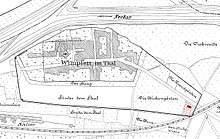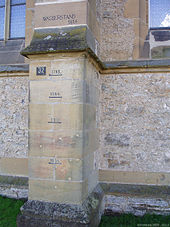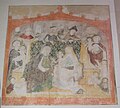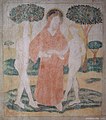Cornelienkirche (Bad Wimpfen)
The Cornelienkirche is a late Gothic Protestant church in Bad Wimpfen . It was not originally, as its name suggests, under the patronage of Cornelius , but under Maria . The otherwise inconspicuous small church is characterized by old wall paintings inside and an artistic portal . In the Thirty Years' War , according to tradition, it served as the headquarters of Tilly during the Battle of Wimpfen , which is why they also popularly Tilly chapel is called.
location
The church is located east of the town center of Wimpfen im Tal on the country road towards Heilbronn, directly at the bridge of the Elsenz Valley Railway across the street. It is about 150 m above sea level, making it the lowest Protestant church in Württemberg . The nearby Neckar repeatedly flooded the church, most recently in 1993. Since then, the embankments have been reinforced. At the church there is a once larger cemetery , where the residents of Jagstfeld , on the other side of the Neckar, were buried in the past .
The church is located at the former east gate of the settlement belonging to the Roman fort Wimpfen in the valley . It is believed that there was already a temple there at the time of the Romans. The modern settlement of Wimpfen in the valley has not reached the extent of the Roman settlement for a long time, so that the Cornelienkirche was outside the village until well into the 20th century, before it gradually expanded to the east beyond the church through residential and commercial development.
history
There has been a church consecrated to Mary since the 14th century , which was first referred to as Cornelienkirche in 1444 ( alias ad Corneliam nominatae ). According to an inscription on the north portal, today's church was built or rebuilt from 1476; the patronage was held by the Worms cathedral chapter . It is not certain where the name Cornelienkirche comes from; it cannot be traced back to St. Cornelius . Presumably it is based on the belief, which was widespread in the chronicle of Dean Burkard von Hall towards the end of the 13th century, that the name of the Roman settlement at the Wimpfener fort was Cornelia .
The building had been in the hands of the city since 1584. According to tradition, Tilly's headquarters was during the Battle of Wimpfen on May 6, 1622 in the Cornelienkirche, where he is said to have drafted the deployment plan for the battle. The church was devastated several times and used as a haystack from 1740. At the beginning of the 19th century it was so run down that it had already been decided to demolish it, but then it did not take place. It was renovated at the beginning of the 20th century and completely restored in 1993. Today it serves the Protestant parish of Bad Wimpfen as another church next to the parish church.
description
architecture
When Cornelie Church is one of exposed stone- built hall church has a rectangular plan. The long sides of the building are structured by windows and buttresses. In the east gable side there is a walled up choir arch. The actual choir , from which remains of the foundations were found, no longer exists or was never completed. The church has no steeple , the roof only supports a small ridge turret .
The interior of the church is marked by the renovation after multiple devastation and years of secular use. With the exception of the stone pulpit and more recently discovered and exposed frescoes and consecration crosses on the walls, nothing of the original interior of the church has been preserved. From the low-slung windows in the east corners, it is concluded that there were side altars in the past. The church was once also covered by a wooden, polygonal openwork barrel roof that reached into the roof structure, but was replaced by a flat wooden ceiling. The interior has recently been divided. In the east of the building, a large church room takes up the largest space. The upper area of the chancel arch was glazed with a Christ motif and received a wooden crucifix above a simple stone altar. To the left of the choir arch, two old grave slabs were placed. In the western part of the building a vestibule, utility areas and in the south-west corner a smaller heated side chapel were separated under the modern gallery .
North portal
Along the Cornelienstrasse is the elaborately designed north portal, the tympanum of which depicts the Annunciation in late Gothic relief sculpture and above it the Trinity . The inscription 1476 hie solt ir schawen die gan zu cornelia our dear frawen is carved into the lintel below the tympanum . The saying roughly means: Here you should see those who go to Cornelia Our Lady and could give clues to a former pilgrimage . The pillar that separates the two doors of the portal was probably once adorned with a statue of the Virgin Mary. The pedestals for the entablature of the canopy, which has probably always existed, are formed by angel consoles whose banners proclaim (translated) In the year of Christ one thousand four hundred seventy-six the first stone was laid . The portal was probably made by a Worms or Rhenish workshop based on a relief from around 1470 in Speyr Cathedral on the tomb of Bishop Siegfried III. Created by Venningen († 1459). It was last preserved in 2004.
The four brackets of the lintel below are each decorated with a coat of arms. The coats of arms represent the founders of the church, the coats of arms of those of Venningen , those of Gemmingen - Neipperg , the coat of arms of the city of Wimpfen and that of Neuhausen can be seen .
West portal
There is another portal crowned by a tympanum in the western gable end. It is more simply designed than the north portal and is attributed to the same workshop. The tympanum shows a crucifixion scene, the coats of arms on the consoles of the lintel are those of Venningen and those of Nippenburg. A third, but unadorned portal was located on the south side of the church and was converted into a window in the side chapel.
Frescoes
In addition to consecration crosses on various walls, frescoes from the 15th century have been preserved on the south wall of the church . The frescoes were painted over for a long time. The inscriptions and details can only be seen in fragments. Above the pulpit is a representation of the holy clan , below is a crucifixion scene . In the middle of the south wall a group of pictures has been preserved: on the left Christ between ears and grapes, above the Annunciation and the Last Judgment , below in eight pictures the Christian creation story from the creation of animals to the fall of the evil angels, the creation of Adam and the Eve, brought together by God the Father, the fall of man and the expulsion from paradise up to the last picture, which shows Adam and Eve working in the fields. A single picture to the right shows Saint Jodocus framed by angels, knights and donors.
literature
- The Cornelienkirche in Bad Wimpfen in the valley . In: The Protestant churches in the Heilbronn church district . Evangelical Church District Heilbronn, Heilbronn 2005. pp. 8–9
- Fritz Arens and Reinhold Bührlen: Wimpfen - history and art monuments . Association Alt-Wimpfen, Bad Wimpfen 1991
Individual evidence
- ↑ a b c d e f g h The Protestant churches in the Heilbronn church district (see literature)
- ↑ Helmut Liebs: Between world record and Swabian modesty. Protestant churches in Württemberg: the smallest and largest, the coldest, the most expensive ( memento from October 15, 2007 in the Internet Archive ) on the website of the Evangelical Church in Württemberg
- ↑ a b c d e f g h Fritz Arens and Reinhold Bührlen: Wimpfen - history and art monuments (see literature)
- ↑ a b c d e Julius Fekete: Art and cultural monuments in the city and district of Heilbronn . 2nd Edition. Theiss, Stuttgart 2002, ISBN 3-8062-1662-2 . P. 113
- ↑ a b c d e Cornelissen, s. Web links
- ↑ Lt. The Protestant churches in the Heilbronn and Arens / Bührlen church district (see literature) in 1902, according to Fekete (see individual records) in 1920
- ↑ Information about the Cornelienkirche on the website of the city of Bad Wimpfen, s. Web links
- ↑ a b c Rudolf Kautzsch: The art monuments in Wimpfen am Neckar , Wimpfen 1925
Web links
- Information about the Cornelienkirche on the website of the city of Bad Wimpfen
- Josef Cornelissen: Cornelien Church in Bad Wimpfen. Named after Roman settlement? on www.cornelissen.de
Coordinates: 49 ° 13 '46.85 " N , 9 ° 11' 8.75" E



























